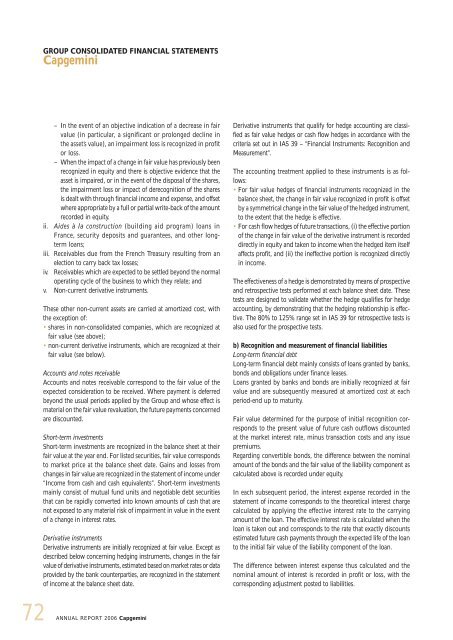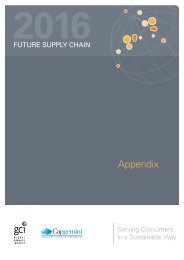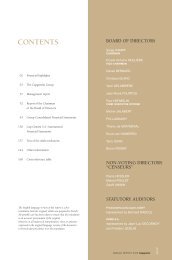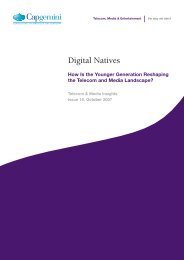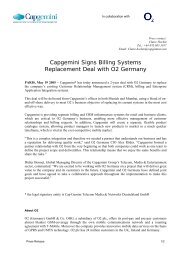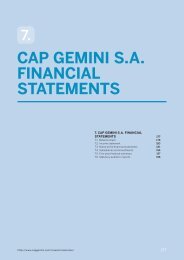You also want an ePaper? Increase the reach of your titles
YUMPU automatically turns print PDFs into web optimized ePapers that Google loves.
72 ANNUAL<br />
GROUP CONSOLIDATED FINANCIAL STATEMENTS<br />
<strong>Capgemini</strong><br />
– In the event of an objective indication of a decrease in fair<br />
value (in particular, a significant or prolonged decline in<br />
the asset’s value), an impairment loss is recognized in profit<br />
or loss.<br />
– When the impact of a change in fair value has previously been<br />
recognized in equity and there is objective evidence that the<br />
asset is impaired, or in the event of the disposal of the shares,<br />
the impairment loss or impact of derecognition of the shares<br />
is dealt with through financial income and expense, and offset<br />
where appropriate by a full or partial write-back of the amount<br />
recorded in equity.<br />
ii. Aides à la construction (building aid program) loans in<br />
France, security deposits and guarantees, and other longterm<br />
loans;<br />
iii. Receivables due from the French Treasury resulting from an<br />
election to carry back tax losses;<br />
iv. Receivables which are expected to be settled beyond the normal<br />
operating cycle of the business to which they relate; and<br />
v. Non-current derivative instruments.<br />
These other non-current assets are carried at amortized cost, with<br />
the exception of:<br />
shares in non-consolidated companies, which are recognized at<br />
fair value (see above);<br />
non-current derivative instruments, which are recognized at their<br />
fair value (see below).<br />
Accounts and notes receivable<br />
Accounts and notes receivable correspond to the fair value of the<br />
expected consideration to be received. Where payment is deferred<br />
beyond the usual periods applied by the Group and whose effect is<br />
material on the fair value revaluation, the future payments concerned<br />
are discounted.<br />
Short-term investments<br />
Short-term investments are recognized in the balance sheet at their<br />
fair value at the year end. For listed securities, fair value corresponds<br />
to market price at the balance sheet date. Gains and losses from<br />
changes in fair value are recognized in the statement of income under<br />
“Income from cash and cash equivalents”. Short-term investments<br />
mainly consist of mutual fund units and negotiable debt securities<br />
that can be rapidly converted into known amounts of cash that are<br />
not exposed to any material risk of impairment in value in the event<br />
of a change in interest rates.<br />
Derivative instruments<br />
Derivative instruments are initially recognized at fair value. Except as<br />
described below concerning hedging instruments, changes in the fair<br />
value of derivative instruments, estimated based on market rates or data<br />
provided by the bank counterparties, are recognized in the statement<br />
of income at the balance sheet date.<br />
REPORT 2006 <strong>Capgemini</strong><br />
Derivative instruments that qualify for hedge accounting are classified<br />
as fair value hedges or cash flow hedges in accordance with the<br />
criteria set out in IAS 39 – “Financial Instruments: Recognition and<br />
Measurement”.<br />
The accounting treatment applied to these instruments is as follows:<br />
For fair value hedges of financial instruments recognized in the<br />
balance sheet, the change in fair value recognized in profit is offset<br />
by a symmetrical change in the fair value of the hedged instrument,<br />
to the extent that the hedge is effective.<br />
For cash flow hedges of future transactions, (i) the effective portion<br />
of the change in fair value of the derivative instrument is recorded<br />
directly in equity and taken to income when the hedged item itself<br />
affects profit, and (ii) the ineffective portion is recognized directly<br />
in income.<br />
The effectiveness of a hedge is demonstrated by means of prospective<br />
and retrospective tests performed at each balance sheet date. These<br />
tests are designed to validate whether the hedge qualifies for hedge<br />
accounting, by demonstrating that the hedging relationship is effective.<br />
The 80% to 125% range set in IAS 39 for retrospective tests is<br />
also used for the prospective tests.<br />
b) Recognition and measurement of financial liabilities<br />
Long-term financial debt<br />
Long-term financial debt mainly consists of loans granted by banks,<br />
bonds and obligations under finance leases.<br />
Loans granted by banks and bonds are initially recognized at fair<br />
value and are subsequently measured at amortized cost at each<br />
period-end up to maturity.<br />
Fair value determined for the purpose of initial recognition corresponds<br />
to the present value of future cash outflows discounted<br />
at the market interest rate, minus transaction costs and any issue<br />
premiums.<br />
Regarding convertible bonds, the difference between the nominal<br />
amount of the bonds and the fair value of the liability component as<br />
calculated above is recorded under equity.<br />
In each subsequent period, the interest expense recorded in the<br />
statement of income corresponds to the theoretical interest charge<br />
calculated by applying the effective interest rate to the carrying<br />
amount of the loan. The effective interest rate is calculated when the<br />
loan is taken out and corresponds to the rate that exactly discounts<br />
estimated future cash payments through the expected life of the loan<br />
to the initial fair value of the liability component of the loan.<br />
The difference between interest expense thus calculated and the<br />
nominal amount of interest is recorded in profit or loss, with the<br />
corresponding adjustment posted to liabilities.


